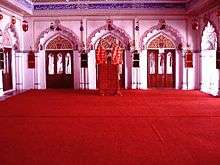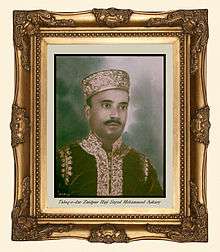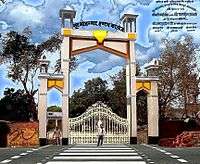Zaidpur
Zaidpur is a town and a nagar panchayat in Barabanki district, Uttar Pradesh, India.
Zaidpur | |
|---|---|
Town | |
 Zaidpur Location in Uttar Pradesh, India | |
| Coordinates: 26.83°N 81.33°E | |
| Country | |
| State | Uttar Pradesh |
| District | Barabanki |
| Founder | Abdullah ''Zar-baqsh |
| Population (2011)[1] | |
| • Total | 34,443 |
| Languages | |
| • Official | Hindi, Urdu |
| Time zone | UTC+5:30 (IST) |
| PIN | 225414 |
| Vehicle registration | UP-41 |
Geography
Zaidpur village covers approximately 3 km2 of non-mountainous terrain.
Location
Zaidpur lies at 26.83°N 81.33°E in India's north east. Its nearest service centre is Nawabganj, approximately 20 km to the northwest and its nearest city is Lucknow, approximately 30 km to the west. Faizabad is further away to the east. Delhi and Agra lie to the west. The border with Nepal lies approximately 150 km to the northeast. Zaidpur's elevation is 109 metres (357 feet).[2][3]
Transport
Zaidpur lies on state highway 13. The nearest passenger airport is the Chaudhary Charan Singh International Airport at Lucknow, 60.2 kilometres (37.4 mi) from Zaidpur.[4]
Hydrology
Derivatives of the Ganga river and Gomti River, local rain in wet months and wells supply water to Zaidpur.[5]
Climate
July is the wettest month in Zaidpur with an average 22 rain days and average monthly precipitation of 237mm. The wet season is between May and September. The hottest month is May with an average high temperature of 40 °C. The coldest month is January with an average low temperature of 8 °C.[6]
Demographics
The Zaidpur Nagar Panchayat has population of 34,443 of which 17,747 are males while 16,696 are females as per report released by 2011 Census of India.[1] Population of Children with age of 0-6 is 5614 which is 16.30% of total population of Zaidpur (NP). In Zaidpur Nagar Panchayat, Female Sex Ratio is of 941 against state average of 912. Moreover, Child Sex Ratio in Zaidpur is around 982 compared to Uttar Pradesh state average of 902. Literacy rate of Zaidpur city is 49.50% lower than state average of 67.68%. In Zaidpur, male literacy is around 55.67% while female literacy rate is 42.89%. Muslims form 81.89% of the total population. Remaining population in overwhelmingly Hindu.[1]
History
Origin
Zaidpur was a Musalman military colony[7] founded in 462 Hijri (1070 AD) by Abdullah Zar-baqsh, an immigrant from Qom, Persia. The settlement was named for Zar-Baksh's only son, Zaid (b. 462 Hijri (1070 AD)).
Zar-baqsh was a descendant of the prophet Muhammad through his daughter, Fatimah and her husband, Ali, and thus was of the Rizvi family, in the 14th generation from Muhammad. Zar-baqsh's father was Yaqoob and his grandfather was Ahmad (924–969 AD), a naqib (official investigator) of Qom.
The list below describes the descendants of Muhammad to Zaid, after whom Zaidpur was named.
- Muhammad.
- Fatimah and his son-in-law Ali ibn Abi Talib
- Husayn ibn Ali-syed e Shuhada.
- Ali ibn Husayn Zayn al-Abidin
- Muhammad al-BaqirBaqir al-Ulum.
- Ja'far al-Sadiq -as-Sadiq.
- Musa al-Kadhim
- Ali al-Ridha
- Muhammad at-Taqi
- Musa al Mubarraqa.
- Abu Maqarem.
- Muhammad al-Aeraj.
- Ahmed.
- Yaqoob.
- Zar-baqsh.
- Zaid.
Zar-baqsh
Zar-baqsh was born and raised in Qom. He later moved to Jajarm, now in current day North Khurasan, Iran. He was a scholar and a spiritual figure with miracles attributed to him. For example, under his spiritual power, gold fell from the sky, leading to his name "Zar-baqsh", the "one who gives gold". Due to persecution of the Saiyeds, (descendants of Muhammad), Zar-baqsh went to Lahore, Hindustan and from there, he travelled east, reaching a place in a forest, with a well, where he founded Zaidpur. This location was 9 miles (14 km) from the fort of Dawood Ghazi of Satrikh, an earlier immigrant, regional Muslim ruler, and a general of the sultan, Mahmood Ghaznavi.
Zar-baqsh married Bibi Yadgaar Bano, daughter of Dawood Ghazi. Dawood Ghazi's Mazaar (mausoleum), the Budhe Baba Ki Mazaar is in Satrikh, Barabanki district. Ghazi Saiyyad Salar Masud (1015–1032CE), the son of Dawood Ghazi and Sitr-e-Mu’alla (the sister of the Sultan Mahmud Ghaznavi ), is entombed in Bahraich. Zar-basqh retired to a quiet spiritual life at the Dada Abdullah Ka Talaab well (known locally as the "Dada Dullan Ka Talab"). Later, a nearby village was founded and named Abdallahpur after Zar-baqsh.
In 1089CE, Zar-baqsh set out on a three-year-long, holy pilgrimage to Mecca. In 493 Hijri (1099CE), he left again. In 493 Hijri (1100CE), in Jajarm, in North Khorasan Province, Iran. Zar-baqsh died of an illness and is buried there.
Zaid
Zaid, the son of Zar-baqsh, was a saintly scholar to whom miracles have been attributed. At eighteen, he married Bibi Kaneez Bano, the daughter of Sulaiman of Satrikh for whom the town, Sulaimanabad is named. Sulaiman was the nephew of Dawood Ghazi.
Before Zar-baqsh left on his pilgrimage, he gave to his son, Zaid, the hereditary and traditional family lore. He also asked that his first born grandson be named Mahmood. The child was born in 1100 AD and a village near Zaidpur was named Mahmoodpur after the boy.
After the death of Zar-baqsh, Zaid retired to a life of solitude and devotion in the mohalla Gadhi-Qadeem in Zaidpur. Zaid died on 16th Rabi-us-Sani, 526 Hijri, 6 March 1132 AD at age 64 and was buried by his mother's side, near the Dada Abdullah Ka Talaab well on the outskirts of Zaidpur.
Notable people from Zaidpur
Saiyyed families
Members of the Saiyyed families of Zaidpur, the Badis and the Chotis became Taluqdars (feudal lords) of Awadh province.[10][11][12]
Mohammad Ashraf "Danishmand", Saiyad-ul-Ulema (1557–1644 AD)

[12]:4, 8 and 29
In about 840 Hijri (1436 AD), Ali-ud-deen, son of Saif-ud-deen Saani, migrated from Zaidpur to Jaunpur. Ali-ud-deen's younger brother, Ziya-ud-deen (Ziya) remained in Zaidpur. Ali-ud-deen's son, Khair-ud-deen was a prosperous man who lived in Nahthor, Bijnaour district. His son, Dawood (Pyaare), grandson, Mohammad (Mangan) and great grandson, Mohammad Saeed also lived in Nahthor. Khair-ud-deen's great great grandson, Mohammad Ashraf (1557-1644 AD) was born in Nahthor. Mohammad Ashraf later moved to Amroha where he died in 1644 AD.
Mohammad Ashraf was a scholar who advocated the use of the intellect in everyday life as a way to find balance and reduce anxiety and extravagances. The Moghul emperor, Barbar, honoured Mohammad Ashraf with the title, Danishmand.
In 1811 AD or earlier, a congregation hall (azakhana or imambarah) and a mosque were built at Danishmandaan, Amroha, by Musammat in memory of her daughter. Further construction was done by Mehdi Raza Taqvi in 1946. Among eight structures at the azakhana, one was a school of Islamic theology, the Noor Ul Madaris.[13][14]
Ghulam Husain, Salim
Ghulam Husain was an historian, antiquarian and archaeologist. Salim was his Takh-al-lus (pen name). After moving to Malda, Salim became a dak munshi (post master) under George Udney, the English commercial resident of Malda. Salim was also a keen student of history. He deciphered inscriptions attached to Mosques and other monuments. He also visited Gaur and Pandua, the two Sultanate capitals of Bengal where most of the monuments were located. In 1786 AD, Udney asked Salim to write the history of Muslim rule. The Riyaz-us-Salatin (Garden of Kings), dated 1788 AD, was the first complete history of Muslim rule in Bengal.[15] The book was written in Persian. It describes Muslim rule from Bakhtiyaar’s conquest of Nadia in 1204 and 1205 AD to the battle of Palasi in 1757 AD. Salim lived in a house which later became a charitable dispensary in Malda.[16] Salim died in 1233 Hijri (1817 AD) and is buried in the Chak Qurban Ali quarter of Malda.[17]

Brigadier Haider Abbas Rizvi
Karam Ali of Zaidpur, the original owner of the Gotia Estate, was a Saiyed, an hakeem (a physician) and a land owner. The last owner of the estate was Haider Abbas Rizvi, a brigadier general of the 1st Punjab Regiment of Her Majesty's Royal Indian Army. He had inherited the land from his father, Mohammad Askari. At the time of Partition, Rizvi retired to Sialkot, in Punjab, Pakistan.
Others
- Allama Najmul Millat
- Hamid Ul Hasan Lucknow
- Mushirul Hasan, writer.[18]
- Bilal Kazmi, poet
Economy
Enterprises in Zaidpur include a postal service; bank; school; an LPG gas agency; sugar cane farming equipment sales; winnowing fan sales; cinema halls; medical services; and small scale textile manufacturing and hub for export quality handloom products and produced a lot of exporters (for example, Dinesh Enterprises scarves and cotton stoles from a tradition of hand-loom weaving).
Education

Noor Muhammad Inter College was founded by Noor Mohammad Seth. In 2007, a modern zaidpur gate with a height of 40 ft was designed and installed by his nephew, Fakhruddin Usmani and his daughter, Sabra Fakhruddin, during a visit from Karachi, Pakistan. also it consist of some private schoolMeritorious Kid's Dream Campus specially for (Playgroup to 5th )and colleges.
References
- http://www.census2011.co.in/data/town/801099-zaidpur-uttar-pradesh.html
- "Zaidpur." Global gazeteer version 2.2 web page 1996 - 2010. Zaidpur, India
- "Zaidpur". Google map. Accessed 24 January 2014.
- "Zaidpur". Closest Airport To website. Accessed 25 January 2014.
- "India river map." Maps of India website. Accessed 24 January 2014.
- "Zaidpur". World weather online website. Accessed 25 January 2014.
- Irwin H. C. "The Garden of India or chapters on Oudh history." Asian Educational Services 2001 p28. ISBN 8120615425, 9788120615427
- Saiyeds of Zaidpur Shajraat-Taiyyabaat (1916).
- Anwaar-e-Qom (1953).
- Azhar M. A. "King Wajid Ali Shah of Awadh" Royal Book Co. 1982 Vol 1.
- Shajraat Taiyyabaat "Genealogy of Saiyeds of Zaidpur." 1916.
- "Anwaar-e-Qom" 1953.
- "Proposed new hall in Danishmandaan." Izonecafe blog January 2013.
- Blochmann H. "Geography and history of Bengal." Journal of the Asiatic Society of Bengal, 1873 Vol 42(1) p210 accessed at Google Books 25 January 2014.
- Bakhsh I. Khurshid Jahan Numa."
- Karim A. Biography of Salim
- Amazon.com page.